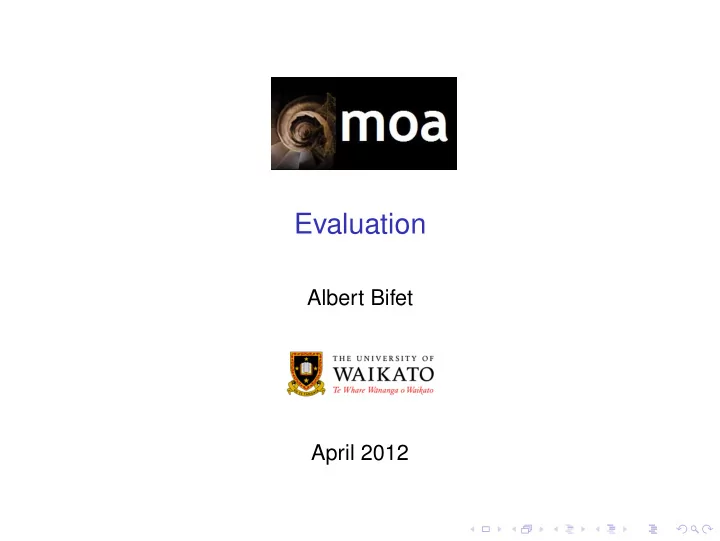

Evaluation Albert Bifet April 2012
COMP423A/COMP523A Data Stream Mining Outline 1. Introduction 2. Stream Algorithmics 3. Concept drift 4. Evaluation 5. Classification 6. Ensemble Methods 7. Regression 8. Clustering 9. Frequent Pattern Mining 10. Distributed Streaming
Data Streams Big Data & Real Time
Data stream classification cycle 1. Process an example at a time, and inspect it only once (at most) 2. Use a limited amount of memory 3. Work in a limited amount of time 4. Be ready to predict at any point
Evaluation 1. Error estimation: Hold-out or Prequential 2. Evaluation performance measures: Accuracy or κ -statistic 3. Statistical significance validation: MacNemar or Nemenyi test Evaluation Framework
Error Estimation Data available for testing ◮ Holdout an independent test set ◮ Apply the current decision model to the test set, at regular time intervals ◮ The loss estimated in the holdout is an unbiased estimator Holdout Evaluation
1. Error Estimation No data available for testing ◮ The error of a model is computed from the sequence of examples. ◮ For each example in the stream, the actual model makes a prediction, and then uses it to update the model. Prequential or Interleaved-Test-Then-Train
1. Error Estimation Hold-out or Prequential? Hold-out is more accurate, but needs data for testing. ◮ Use prequential to approximate Hold-out ◮ Estimate accuracy using sliding windows or fading factors Hold-out or Prequential or Interleaved-Test-Then-Train
2. Evaluation performance measures Predicted Predicted Class+ Class- Total Correct Class+ 75 8 83 Correct Class- 7 10 17 Total 82 18 100 Table : Simple confusion matrix example 100 + 10 75 100 = 75 100 + 10 83 17 ◮ Accuracy = 100 = 85 % 83 17 ◮ Arithmetic mean = ( 75 83 + 10 17 ) / 2 = 74 . 59 % � 75 10 ◮ Geometric mean = 17 = 72 . 90 % 83
2. Performance Measures with Unbalanced Classes Predicted Predicted Class+ Class- Total Correct Class+ 75 8 83 Correct Class- 7 10 17 Total 82 18 100 Table : Simple confusion matrix example Predicted Predicted Class+ Class- Total Correct Class+ 68.06 14.94 83 Correct Class- 13.94 3.06 17 Total 82 18 100 Table : Confusion matrix for chance predictor
2. Performance Measures with Unbalanced Classes Kappa Statistic ◮ p 0 : classifier’s prequential accuracy ◮ p c : probability that a chance classifier makes a correct prediction. ◮ κ statistic κ = p 0 − p c 1 − p c ◮ κ = 1 if the classifier is always correct ◮ κ = 0 if the predictions coincide with the correct ones as often as those of the chance classifier Forgetting mechanism for estimating prequential kappa Sliding window of size w with the most recent observations
3. Statistical significance validation (2 Classifiers) Classifier A Classifier A Class+ Class- Total Classifier B Class+ c a c+a Classifier B Class- b d b+d Total c+b a+d a+b+c+d M = | a − b − 1 | 2 / ( a + b ) The test follows the χ 2 distribution. At 0 . 99 confidence it rejects the null hypothesis (the performances are equal) if M > 6 . 635. McNemar test
3. Statistical significance validation ( > 2 Classifiers) Two classifiers are performing differently if the corresponding average ranks differ by at least the critical difference � k ( k + 1 ) CD = q α 6 N ◮ k is the number of learners, N is the number of datasets, ◮ critical values q α are based on the Studentized range √ statistic divided by 2. Nemenyi test
3. Statistical significance validation ( > 2 Classifiers) Two classifiers are performing differently if the corresponding average ranks differ by at least the critical difference � k ( k + 1 ) CD = q α 6 N ◮ k is the number of learners, N is the number of datasets, ◮ critical values q α are based on the Studentized range √ statistic divided by 2. # classifiers 2 3 4 5 6 7 q 0 . 05 1.960 2.343 2.569 2.728 2.850 2.949 q 0 . 10 1.645 2.052 2.291 2.459 2.589 2.693 Table : Critical values for the Nemenyi test
Cost Evaluation Example Accuracy Time Memory Classifier A 70% 100 20 Classifier B 80% 20 40 Which classifier is performing better?
RAM-Hours RAM-Hour Every GB of RAM deployed for 1 hour Cloud Computing Rental Cost Options
Cost Evaluation Example Accuracy Time Memory RAM-Hours Classifier A 70% 100 20 2,000 Classifier B 80% 20 40 800 Which classifier is performing better?
Evaluation 1. Error estimation: Hold-out or Prequential 2. Evaluation performance measures: Accuracy or κ -statistic 3. Statistical significance validation: MacNemar or Nemenyi test 4. Resources needed : time and memory or RAM-Hours Evaluation Framework
Recommend
More recommend